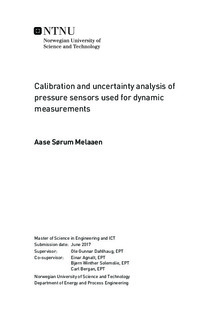Calibration and uncertainty analysis of pressure sensors used for dynamic measurements
Master thesis
Permanent lenke
http://hdl.handle.net/11250/2454919Utgivelsesdato
2017Metadata
Vis full innførselSamlinger
Sammendrag
Dynamic calibration of pressure sensors is challenging. Often, steady-state calibration is applied on pressure sensors used to measure dynamical measurements. Steady-state calibration does not represent the dynamic behavior of a sensor. With dynamical calibration the quality of a dynamical measurement increases. This is the motivation for my master s thesis, written at the Waterpower Laboratory at NTNU in spring 2017. The master s thesis investigates methods for performing dynamic calibration. The best method is believed to be the use of an aperiodic pressure generator, because of its large range of frequencies and pressures, and in addition, the low cost and simple construction. The dynamic calibration method developed in this master s thesis is based on a step-response method with use of ultra-fast diaphragm valves with response time less than 5 ms.
The target was to build a functional dynamic calibration system, and by use of the system, find the natural frequency of the calibrated sensor. By finding the natural frequency of the calibrated sensor, it is possible to find the uncertainty in dynamic measurements, and therefore increase the quality of the measurements.
To generate a perfect working dynamic calibration system was proven to be difficult. The first problem arose when it was realized that the machining of the calibration system was not done according to the drawings. These inaccuracies resulted in air pockets in the system that was impossible to deflate, and as a consequence, signal noise was observed in the pressure step. The second problem was the behavior of the diaphragm valves. When the valve opened, the open-valve position was not fixed, and the diaphragm piston started to oscillate. This led to slow fluctuations prior to the final state after the step. The slow fluctuations worked as a low pass filter and delayed the entire system. This caused a slow rise time of the step generated.
The closing position of the valves was fixed, and here the slow fluctuations did not occur, and the rise time improved. The calibration system does still not work in a perfect manner, but has a range of application. An almost suitable step was generated, and with use of Fast Fourier Transform it could be indicated that the highest natural frequency achieved by the system was 2246Hz. By knowing this frequency and with use of a reference sensor it can be determined if a calibrated sensor does not need an extra uncertainty term. The dynamic calibration system developed could also be used to verify if a dynamic pressure sensor and amplifier behave in a correct manner. However, these methods need further investigation by experiments. Further work has also been an important part of this master s thesis.
